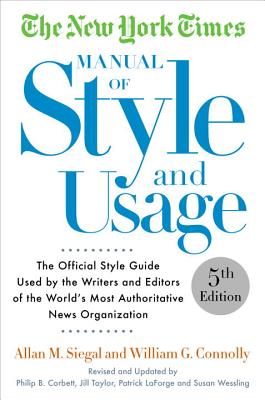The New York Times Manual of Style and Usage: The Official Style Guide Used by the Writers and Editors of the World's Most Authoritative News Organiza

The New York Times Manual of Style and Usage: The Official Style Guide Used by the Writers and Editors of the World's Most Authoritative News Organiza
The premier source for journalists, now revised and updated for 2015. Does the White House tweet?
Or does the White House post on Twitter?
Can "text" be a verb and also a noun?
When should you link?
For anyone who writes--short stories or business plans, book reports or news articles--knotty choices of spelling, grammar, punctuation and meaning lurk in every line: Lay or lie? Who or whom? That or which? Is Band-Aid still a trademark? It's enough to send you in search of a Martini. (Or is that a martini?) Now everyone can find answers to these and thousands of other questions in the handy alphabetical guide used by the writers and editors of the world's most authoritative news organization. The guidelines to hyphenation, punctuation, capitalization and spelling are crisp and compact, created for instant reference in the rush of daily deadlines. The 2015 edition is a revised and condensed version of the classic guide, updated with solutions to problems that plague writers in the Internet age:
- How to cite links and blogs
- How to handle tweets, hashtags and other social-media content
- How to use current terms like "transgender," or to choose thoughtfully between "same-sex marriage" and "gay marriage" With wry wit, the authors have created an essential and entertaining reference tool.
The premier source for journalists, now revised and updated for 2015. Does the White House tweet?
Or does the White House post on Twitter?
Can text be a verb and also a noun?
When should you link?
For anyone who writes--short stories or business plans, book reports or news articles--knotty choices of spelling, grammar, punctuation and meaning lurk in every line: Lay or lie? Who or whom? That or which? Is Band-Aid still a trademark? It's enough to send you in search of a Martini. (Or is that a martini?) Now everyone can find answers to these and thousands of other questions in the handy alphabetical guide used by the writers and editors of the world's most authoritative news organization. The guidelines to hyphenation, punctuation, capitalization and spelling are crisp and compact, created for instant reference in the rush of daily deadlines. The 2015 edition is a revised and condensed version of the classic guide, updated with solutions to problems that plague writers in the Internet age:
- How to cite links and blogs
- How to handle tweets, hashtags and other social-media content
- How to use current te
Descrierea produsului
The premier source for journalists, now revised and updated for 2015. Does the White House tweet?
Or does the White House post on Twitter?
Can "text" be a verb and also a noun?
When should you link?
For anyone who writes--short stories or business plans, book reports or news articles--knotty choices of spelling, grammar, punctuation and meaning lurk in every line: Lay or lie? Who or whom? That or which? Is Band-Aid still a trademark? It's enough to send you in search of a Martini. (Or is that a martini?) Now everyone can find answers to these and thousands of other questions in the handy alphabetical guide used by the writers and editors of the world's most authoritative news organization. The guidelines to hyphenation, punctuation, capitalization and spelling are crisp and compact, created for instant reference in the rush of daily deadlines. The 2015 edition is a revised and condensed version of the classic guide, updated with solutions to problems that plague writers in the Internet age:
- How to cite links and blogs
- How to handle tweets, hashtags and other social-media content
- How to use current terms like "transgender," or to choose thoughtfully between "same-sex marriage" and "gay marriage" With wry wit, the authors have created an essential and entertaining reference tool.
The premier source for journalists, now revised and updated for 2015. Does the White House tweet?
Or does the White House post on Twitter?
Can text be a verb and also a noun?
When should you link?
For anyone who writes--short stories or business plans, book reports or news articles--knotty choices of spelling, grammar, punctuation and meaning lurk in every line: Lay or lie? Who or whom? That or which? Is Band-Aid still a trademark? It's enough to send you in search of a Martini. (Or is that a martini?) Now everyone can find answers to these and thousands of other questions in the handy alphabetical guide used by the writers and editors of the world's most authoritative news organization. The guidelines to hyphenation, punctuation, capitalization and spelling are crisp and compact, created for instant reference in the rush of daily deadlines. The 2015 edition is a revised and condensed version of the classic guide, updated with solutions to problems that plague writers in the Internet age:
- How to cite links and blogs
- How to handle tweets, hashtags and other social-media content
- How to use current te
Detaliile produsului












